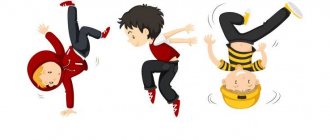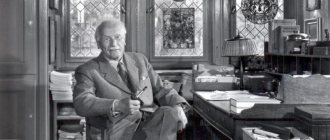Obsessive-compulsive neurosis - symptoms and treatment
Psychoanalytic theory. According to Freud, obsessive thoughts arise from the suppression of aggressive and sexual drives. These symptoms develop as a result of regression to the anal stage (the second stage of psychosexual development according to S. Freud, which begins at the age of 18 months and ends by three years) [7]. Regression depends on one of the following factors or a combination of them:
- defensive ego;
- residual phenomena of the anal-sadistic stage of development;
- phallic organization [3].
There was no objective evidence in the stated theory, so only some scientists consider it possible to consider it as an explanation for the cause of OCD.
Neurochemical theory. This theory was put forward by I.P. Pavlov; it is based on the role of acetylcholine and adrenaline metabolism [14]. Further, the occurrence of OCD has been described as a result of disturbances in serotonin metabolism.
The evidence was a comparison of the effectiveness of serotonin reuptake inhibitors, non-serotonergic drugs and placebo tablets in OCD. Strong correlations between plasma levels of clomipramine (an antidepressant) and reduction in OCD symptoms further supported the role of serotonin in the development of this disorder. However, the study of serotonin metabolism in OCD patients has not yet been sufficiently effective. Contrary to this theory, clomipramine is in some cases better at reducing OCD symptoms than selective serotonin reuptake inhibitors such as fluoxetine, fluvoxine and sertraline [4].
Neuroanatomical theory. Based on the results of special studies, neuroanatomical justifications for OCD were obtained. Frontal lobe dysfunction has been identified in many patients with OCD, but only a few researchers have been able to confirm this. Additional evidence for the involvement of the frontal lobe in the development of OCD has been the use of effective psychosurgical techniques such as capsulotomy and cingulotomy (targeted damage to brain structures whose activity causes the disease).
Evidence of neurobiological disorders in OCD is the connection of this disorder with another pathology, which is based on processes in the basal ganglia (lethargic encephalitis, Sydenham's chorea and Gilles de la Tourette's syndrome). Also, based on the results of four studies that assessed the metabolic activity of the brain using positron emission tomography, it was proven that metabolism in this disorder is increased in the prefrontal cortex [4].
Memory
Intrusive memories
According to P. Janet (1903): “in all obsessions we invariably find the nature of an automatic repetition of the past, without connection, without relation to the external conditions of the present time, i.e.
without actual synthesis." Intrusive memories are also observed in healthy people. They can relate to a melody, a song, a line from a poem, a name, a number, a visual image, etc.
Patients note obsessive memories of events, scenes, actions performed, and difficult experiences of a frightening nature that worried them in the past.
In his lectures on general psychopathology A.V. Snezhnevsky (1962), regarding the pathology of obsessive memories, wrote: “The patient, against his will, must remember the name, patronymic, year of birth of his acquaintances, the circumstances of meetings with them, when he last saw them, what date, what the weather was like on that day . He tries to get rid of it, but to no avail.
Some patients have an obsessive desire to remember the numbers of tram cars.” A.V. Snezhnevsky believed that there are also “sensual obsessive memories” relating to some unpleasant event.
Some usually negative fact from past events, an unpleasant impression, a failure, a mistake made constantly pops up in the mind and is reproduced, and such a memory is accompanied by an unpleasant and painful feeling.
Note that such memories especially often appear before bedtime, during insomnia. In this case, insignificant facts acquire special significance.
Sometimes intrusive memories can be fragmentary, so V.P. Chizh (1911), in his psychiatry textbook, gives an example of a patient who constantly recalled the phrase he read in the book: “a crowd of beggars surrounded the temple,” and this phrase remained in the mind for a long time, although it was not directly related to the patient.
A Berlin doctor of the early twentieth century, J. Friedman (1901), described a case of an obsessive memory arising in a young girl: “As she was leaving the room, she heard a child screaming as a child fell out of the window. Since then, the memory of this misfortune constantly reminded itself every time she was about to open the door, and brought her to the point that she was afraid to leave the room for anything at all.”
According to A. Moll (1906), in a number of cases, “the influencing cause, the defining moment, has long been erased from memory, and yet the obsessive idea generated by it emerges every time for the same reason.”
Sometimes, on the contrary, the desire to remember something becomes obsessive: a name, a number, an excerpt from a film or book, the motive of some melody.
Intrusive reminiscences are sometimes referred to by the term onomamania . They are expressed in an obsessive desire to recall unnecessary terms and events of the day in their chronological sequence.
Some patients check their feelings and thoughts. Until these doubts are eliminated in one way or another, the patient cannot do anything.
The etiology of testing actions, as a rule, lies in the past negative experience of combining psychotraumatic events (robbery, arson, flooding, etc.) with neutral stimuli (closing a door, chimney, water tap, etc.).
Perhaps, in the origin of these states, a feature of memory plays a role, in particular, a certain predisposition to a vivid and vivid consolidation of certain events in memory (“metamemory”).
Note that the memory of patients prone to testing actions is characterized by some deterioration and/or emphasizing the significance of the subjective assessment of ongoing events.
Studies examining verbal and nonverbal memory in similar patients have yielded conflicting results.
Obsessive memories, as well as obsessive fears, can transform into contrasting desires.
Often, intrusive memories are striking in their detail, and they can concern both recent events and distant episodes of life.
Diagnostics
Diagnosis of obsessive-compulsive neurosis in our practice usually does not cause difficulties. Typical symptoms clearly indicate the diagnosis. A differential diagnosis is carried out with psychasthenia, which is a special personality type, manifested by symptoms such as self-doubt, anxiety, and suspiciousness. Obsessive neurosis usually occurs in people who have weakness or low mobility of nervous processes, who are fearful, anxious, suspicious, or hyper-conscientious. In case of neurosis of obsessive movements, it is necessary to exclude neurotic tics. With obsessive-compulsive neurosis, revival of periosteal and tendon reflexes, trembling of the fingers of outstretched arms, vegetative-vascular and autonomic disorders, hyperhidrosis of the hands (increased sweating of the hands) are observed.
Reasons for the development of OCD
The formation of the disorder is essentially based on three factors:
- A biological factor, including disturbances in the functioning of neurotransmitters, cellular metabolism of the brain or autonomic nervous activity, traumatic brain injury and heredity, and the latter is not the underlying cause.
- Social, which implies strict boundaries and norms imposed on the child in childhood in the family or any other system in which he lived or communicated.
- Psychological includes both character accentuations (pronounced traits that influence the behavioral aspect), as well as traumatic circumstances.
From the point of view of Gestalt psychology, the formation of the disorder is perfectly demonstrated in the famous film “The Aviator”, which, by the way, is highly recommended for viewing by patients with this syndrome. In the case of the main character, two factors were involved: biological (genetic predisposition passed on from the mother) and social (an unhealthy pattern of behavior imposed by her). Every time she washed her child, she said, like a mantra, that there was an infection everywhere, from which everyone was dying. Thus, she transferred her anxiety and overprotection to the child. Thus, in light of the social aspect, the boy grew up in an artificially created environment in which any stressful situation triggered an increase in symptoms with accentuation.
How to deal with annoying memories?
To stop being a prisoner of memories, you need to remove the emotional charge from the situation in the past. Sometimes a person just needs to speak out, sometimes to visit a certain place, sometimes to ask for forgiveness, sometimes to forgive himself. However, most often a person needs outside help.
You should contact a psychologist or a close friend immediately at the first signs of falling into a depressive state. It is difficult to help an emotionally unstable person who has withdrawn into himself and experiences traumatic events over and over again.
Unsolicited memories of painful or happy moments are a signal that a person does not live in the present, and therefore does not use his capabilities here and now. To cope with difficult memories on your own, you need to learn to monitor your emotional and physical state.
Prevention of the stressful state of “return to the past”:
- At the first signs of a stressful state in the body, you need to relax and rest. Perhaps the body lacks sleep, a change of environment, vitamins and proper nutrition.
- If a situation in the present triggers memories, you need to learn to shift your focus to other things.
- The emotional reaction to what is happening can be reduced through meditation, heart-to-heart conversations with loved ones, and identifying the true reason for returning to the past. We need to answer the questions: Why do I blame myself for the past? What could I have changed in that situation? What can I do now to stop reliving the situation over and over again?
- To work in depth with an emotional reaction to events in the past, you need to contact a qualified and experienced psychologist.
Any situation in the past is an important lesson that must be learned. The past cannot be changed. You can draw conclusions from any situation and move on. Even the most painful memories can become a tool for working on yourself. Otherwise, a person does not use the opportunities of the present and destroys his future.
The past cannot be forgotten. You need to learn to use it as invaluable experience.
It will be interesting to know who extroverts are.
What is obsessive neurosis?
Obsessive neurosis , or obsessive-compulsive neurosis , is a type of neurosis that manifests itself in irresistibly arising, involuntary, alien
person, fears, doubts, thoughts, movements, concepts, ideas, drives, memories, actions, while maintaining a critical attitude towards them and unsuccessful attempts to combat them.
How to get rid of obsessive thoughts
Stopping obsessive thoughts
Most studies confirm that attempts to stop negative thoughts do not bring the expected results; on the contrary, they intensify obsessions. Therefore, you should focus on rethinking your obsessive thoughts, changing cognitive strategies, and reducing anxiety.
Raise awareness
Thoughts and behavior do not arise by chance. They are the result of deeply ingrained thought patterns or triggers that may or may not be conscious. Being aware of these triggers helps people better manage their reactions. Common triggers include:
- Stress
- Reflections on an event that happened in the past
- Significant life changes (graduation, marriage, birth of a child)
- Receiving bad news (job loss, death of a loved one)
- Sudden and unexpected changes
Changing Thinking Patterns
Most intrusive thoughts are rooted in faulty thinking patterns. Although thoughts may seem realistic and reasonable, all thoughts are always subjective and, accordingly, conclusions are too. Cognitive-behavioral psychotherapy turned out to be the most effective in correcting them .
Coping with fears and anxieties
Behind every obsessive thought lies a strong fear. Fears vary, but they are often based on feelings of loss, abandonment, or general insecurity. These fears are not always completely irrational. Often behind them lies a certain amount of truth, which a person exaggerates so that fear and anxiety become the only reality for him, requiring complete concentration on the threat.
It is worth noting that fear is necessary for all people as an important component of survival; it is what forces people to be alert and active in their environment. Therefore, the goal is not to reduce fear, but to get used to it, figuratively speaking, “train the fear muscle.” Exposure psychotherapy (prevention of exposure and reaction) copes most successfully with this task Please note that it should be used strictly under the supervision of a professional psychotherapist or medical psychologist in order to avoid unforeseen negative effects. This is believed to be the most effective way to reduce the frequency and intensity of intrusive thoughts.
Additionally, mindfulness and acceptance psychotherapy, desensitization, relaxation methods on the recommendation of a psychotherapist or medical psychologist, and other methods can be used.
In this case, individual psychotherapy is often aimed at:
- creating a favorable space for processing psychological trauma, life difficulties and stressors,
- stabilization of the emotional background, development of adequate healthy emotional reactions,
- identifying individual triggers of obsessive thoughts,
- changing reactions to other sources of stress (relationships, work, self-esteem problems, depression, anxiety disorders) that may contribute to maladaptive thinking,
- developing and implementing healthier coping skills,
- increasing self-esteem and building a working model of keeping it at a healthy level;
- changing and practicing a new way of thinking,
- providing a supportive space to process past traumas
- in more complex cases, psychotherapy will be aimed at treating other concomitant mental disorders (anxiety disorder, depression, eating disorder, PTSD, etc.).
Psychotherapy methods are selected individually in each specific case, taking into account symptoms, concomitant disorders, individual characteristics of a person with obsessions, and are recommended at the first psychotherapeutic consultation.
Drug treatment
Pharmacological treatment may temporarily reduce symptoms, but non-pharmacological psychotherapy or a combination of these approaches must be used to achieve long-term remission. A psychotherapist may prescribe antidepressants, anxiolytics, antipsychotics, antipsychotics or other drugs, depending on each specific case. Self-medication is unacceptable, as is the prescription of medications by other specialists (even with medical education) in order to avoid unaccounted negative side effects and aggravation of health problems.
Obsessive fears (phobias), neurosis of obsessive fears, phobias
Obsessive fears occur very often in women and men, girls and boys. There are many types of obsessive fears.
Ereytophobia is the fear of blushing in a public place or in front of people.
Thanatophobia – fear of dying, fear of death.
Syphilophobia – fear of contracting a sexually transmitted disease or venereal disease.
Mysophobia is the fear of pollution.
Claustrophobia is the fear of closed spaces.
Cardiophobia is the fear of contracting any heart disease.
Cancerophobia is the fear of getting cancer.
Heart attack phobia is the fear of getting a myocardial infarction, or of the brain or internal organs.
Dysmorphophobia is the fear of ugliness.
Homilophobia is the fear of crowds.
Acarophobia is the fear of sharp things and objects.
Agoraphobia is the fear of wide areas and spaces.
Sarklinik provides treatment for phobias , various types of fears in Saratov, treatment for fear of blushing. Sarklinik knows how to get rid of phobias and fear, how to deal with phobias, how to deal with phobias, how to cure a phobia, how to overcome a phobia in Saratov, is it possible to get rid of a phobia yourself online, will hypnosis and psychology help, homeopathy, folk methods, folk methods, traditional treatment. Phobias of men, phobias of women, phobias of teenagers, phobias of children, ducks, snakes, spiders, loneliness, dirt, insects, heights, blood, and children's phobias are successfully treated.
What exactly is the problem?
It seems like a man lives for himself and washes his hands. And to your health! Of course, it makes sense to worry when it comes to alcohol, drug addiction and other extreme manifestations. But in general, you can live.
Can. But it's difficult. Obsessive-compulsive disorder is a trap of our subconscious. At the initial stage, the person took some action and relieved internal tension. But gradually you have to discharge more and more often. And now you need to wash your hands not 10, but 20, 30, 40 times a day. And this is a problem that causes significant discomfort: work, family, relationships with loved ones fade into the background. It becomes difficult to concentrate on anything other than your neurosis. Therefore, it is better to consult a psychotherapist in a timely manner.
Treatment of OCD
As with any other neurological disorder, in severe cases it is necessary to involve a team of specialists (psychotherapist, neurologist, psychiatrist) capable of applying a range of measures, including drug therapy.
During stress caused by an obsessive-phobic state, nerve cells are destroyed much faster, and the functional centers of the brain begin to work less and less. It is impossible to normalize and facilitate this process without the use of medications, which is why patients are prescribed drugs from the class of tranquilizers and antidepressants. When brain activity is more or less restored, the use of a psychotherapeutic approach, which plays a major role in treating the disorder, turns out to be more effective.
Psychotherapy methods
The essence of psychotherapy is awareness and acceptance of your suppressed feelings and emotions. It is important to note that psychotherapeutic treatment is quite multifaceted and includes a number of different techniques. For example, cognitive behavioral therapy leads the patient to recognize the irrationality of his behavior and beliefs. It involves increasing the irritating stimulus by gradually immersing the patient in a stressful situation until the level of reaction decreases. This approach, which we have already touched upon in self-help methods, is called the “exposure method” and has proven itself very well. Behavioral exposure tasks can have different mechanics depending on the symptomatology. When treating obsessions, a person is asked to reproduce a thought intentionally and a certain number of times. If the obsession comes 5 times, then it should be deliberately repeated 10 times, or even better, prescribed. The situation with rituals is similar. By increasing the irritating and frightening factor and deliberately immersing oneself in it, the patient’s symptom goes away, but, unfortunately, the problem itself is not solved. That is why at one stage of cognitive behavioral therapy the techniques of gestalt and psychoanalysis are used.
Gestalt therapy
It consists of a dialogue between the individual and the subpersonality, which encourages deviance from within. A conversation with a subpersonality is a kind of acquaintance with oneself, which can provide answers to many internal questions, gradually revealing unspoken grievances and suppressed feelings that torment the patient. With this technique, the intrapersonal conflict that lies on the surface is revealed quite simply, but there is also a deeper layer.
Psycholysis or depth psychotherapy
Finding the source of stress and working with it. Most often, the root cause lies in close relationships in which the patient’s sphere of feelings is suppressed. For example, a child in childhood was forbidden to express his feelings, denied affection or empathy, hence, accordingly, anxiety arose, and therefore obsession and its symptomatic manifestations.
Internal dialogue
This is another method of treatment that is mandatory, since through it the patient becomes able to distinguish between a sick thought and a healthy one in his head, beginning to influence the sick part with his healthy part. Fear is a manifestation of the inner child, with which the adult part is able to work.
In general, any psychotherapeutic technique aims to help in recognizing the problem and in externalizing internal obsessions. As soon as the unconscious enters the plane of awareness, it becomes under our control, we can control it.











